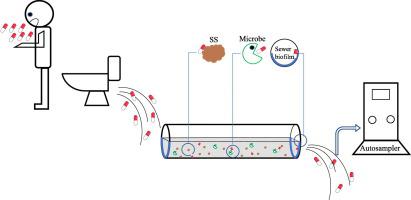Science of the Total Environment ( IF 9.8 ) Pub Date : 2020-09-21 , DOI: 10.1016/j.scitotenv.2020.142414 Wenting Lin , Zhishan Huang , Shiyu Gao , Zhifeng Luo , Wenxuan An , Ping Li , Senwen Ping , Yuan Ren

|
Wastewater-based epidemiology (WBE) is considered as an effective tool for monitoring drug consumption, which is often obtained by back-calculation using the influent concentration and other parameters of wastewater treatment plants. Lack of information on the transformation of drugs in municipal wastewater and sewers may lead to inaccurate consumption estimation. Fourteen prescription drugs in four major categories of diseases (cardiovascular, diabetes, depression, and asthma) were selected to study their adsorption and biodegradation in wastewater and biofilm sewers under different temperatures, pH and biofilms conditions. The result demonstrated that the decay percentage of drugs in wastewater is increased with temperature. Within 72 h, eleven of these 14 drugs, such as metformin, metoprolol, bezafibrate have decay percentages below 20% in wastewater, which are considered as stable drugs; and the decay percentages of the other three, monluster, paroxetine, and sertraline, are greater than 20%, which are the most unstable drugs. In lab-scale aerobic and anaerobic sewers, the decay percentages of metformin, glipizide, metoprolol, gemfibrozil, and atorvastatin are less than 20% within 24 h. The decay percentages of venlafaxine, citalopram, fluoxetine, salmeterol, and salbutamol within 24 h are 20%~60% and paroxetine and sertraline are close to or even exceed 80% within 6 h. Biodegradation of drugs in sewers with aerobic or anaerobic biofilms is higher than that in wastewater systems without biofilms. The result showed that when the per capita consumption of drugs is estimated by using the WBE method, the stability of drugs in wastewater and different types of sewers will significantly affect their residual concentrations.
中文翻译:

基于废水流行病学评估市政污水和下水道中处方药的稳定性
基于废水的流行病学(WBE)被认为是监测药物消耗的有效工具,通常可以通过使用废水处理厂的进水浓度和其他参数进行反算来获得药物消耗。缺乏有关市政废水和下水道中药物转化的信息,可能会导致消费估算不准确。选择了四种主要疾病(心血管疾病,糖尿病,抑郁症和哮喘)中的14种处方药,以研究它们在不同温度,pH和生物膜条件下在废水和生物膜下水道中的吸附和生物降解。结果表明,废水中药物的衰减百分比随温度的升高而增加。在72小时内,这14种药物中的11种,例如二甲双胍,美托洛尔,苯扎贝特在废水中的衰减百分比低于20%,被认为是稳定药物;其他三种药物(孟鲁司特,帕罗西汀和舍曲林)的衰减百分比均大于20%,是最不稳定的药物。在实验室规模的需氧和厌氧下水道中,二甲双胍,格列吡嗪,美托洛尔,吉非贝齐和阿托伐他汀的降解百分数在24小时内小于20%。文拉法辛,西酞普兰,氟西汀,沙美特罗和沙丁胺醇在24小时内的衰减百分比为20%〜60%,帕罗西汀和舍曲林在6小时内的衰减百分比接近或什至超过80%。具有好氧或厌氧生物膜的下水道中药物的生物降解率高于没有生物膜的污水系统中的生物降解率。结果表明,使用WBE方法估算人均药品消费量时,


























 京公网安备 11010802027423号
京公网安备 11010802027423号